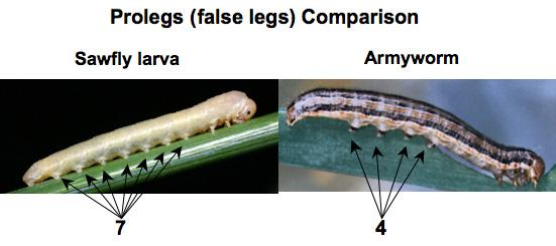By Emily Zobel, Agriculture Agent Associate
University of Maryland Extension, Dorchester County
Grass sawflies can cause damage to both barley and wheat. Grass sawfly larvae hatch and feed on the lower leaf blade in early May. As it grows, the larvae will climb and continue to feed on stems and leaves. Stem and head clipping often occur before leaf feeding is complete and/or the grain reaches physiological maturity. A sawfly larva may clip >10 heads before it matures and drops to the ground.
The grass sawfly larvae can be distinguished from other pests by their solid green color, amber head with a brown band and many legs. Sawfly larvae are often mistaken as caterpillars, but are actually in the insect order Hymenoptera (wasp, bees, and ants). You can tell the difference between a caterpillar and sawfly larvae by counting the number of prologs. Caterpillars will have 5 or fewer pairs of pro-legs while sawfly larvae will have 6 or more pairs of pro-legs (Figure 1).

You can scout for sawfly larvae and armyworms by shaking stems. Shake both sides of 5 linear feet of row and examine any worms that fall off between the 2 rows and note any head clipping. Repeat for at least 10 sites. The threshold for sawfly larva and armyworm is when the larvae number more than 0.4 per linear ft. of row or 0.7 per square ft. and are smaller than ¾ inch. If the larvae are over 1 inch, have a dark bar on the head capsule, and have clipped many heads, it is probably too late to treat.
Some chemical control options are as follows: BaythroidXL (beta-cyfluthrin), Besiege (lambda-cyhalothrin+ chlorantraniliprole), Blackhawk 36WG(spinosad), Mustang MAXX 0.8 EC (zeta-cypermethrin), Radiant SC (spinetoram, Warrior II (lambda-cyhalothrin), and Tombstone 2 EC (cyfluthrin). Remember the label is the law. Be sure to read the label before making any pesticide applications and observe all label restrictions. Please check the label for rates and pre-harvest interval and restrictions.
Article adapted from information from University of Maryland and University of Delaware.
